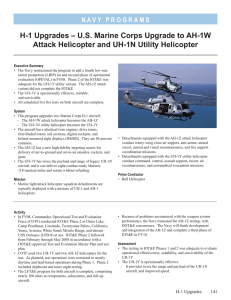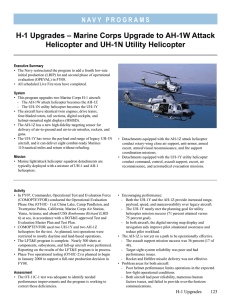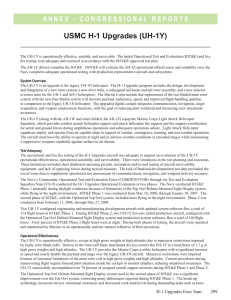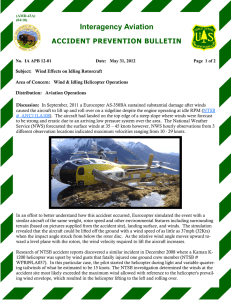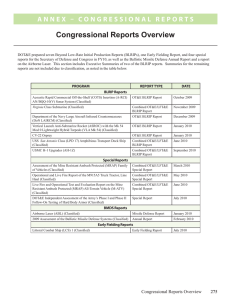H-1 Upgrades – U.S. Marine Corps Upgrade to AH-1W
advertisement
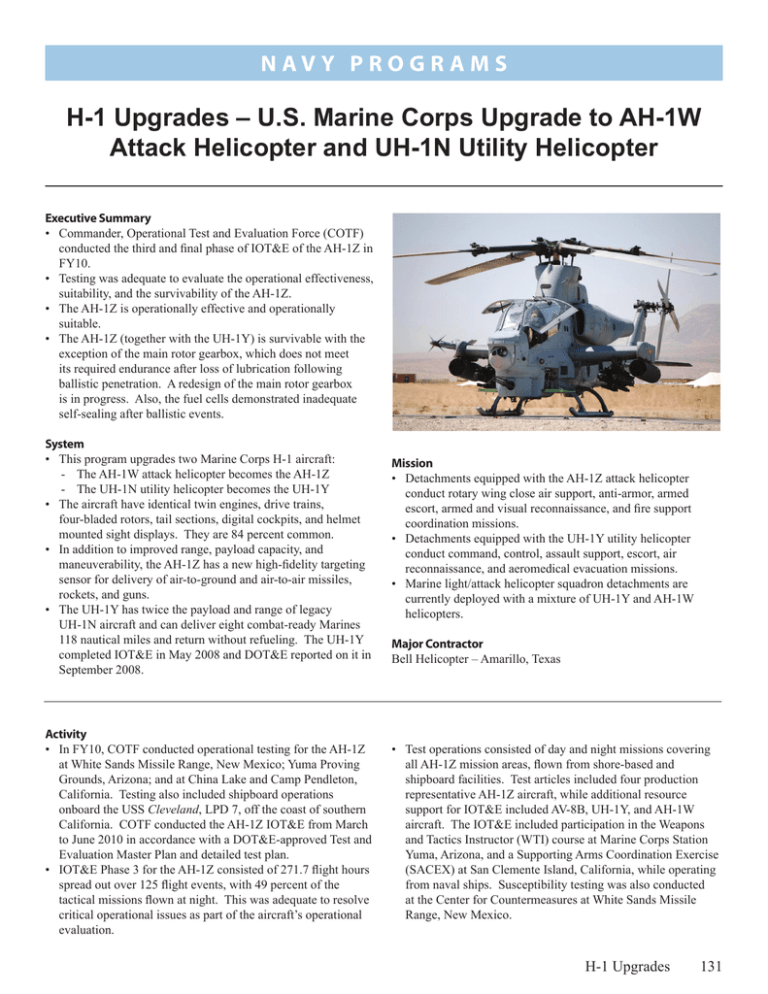
N a v y P ROGRAMS H-1 Upgrades – U.S. Marine Corps Upgrade to AH-1W Attack Helicopter and UH-1N Utility Helicopter Executive Summary • Commander, Operational Test and Evaluation Force (COTF) conducted the third and final phase of IOT&E of the AH-1Z in FY10. • Testing was adequate to evaluate the operational effectiveness, suitability, and the survivability of the AH-1Z. • The AH-1Z is operationally effective and operationally suitable. • The AH-1Z (together with the UH-1Y) is survivable with the exception of the main rotor gearbox, which does not meet its required endurance after loss of lubrication following ballistic penetration. A redesign of the main rotor gearbox is in progress. Also, the fuel cells demonstrated inadequate self‑sealing after ballistic events. System • This program upgrades two Marine Corps H-1 aircraft: - The AH-1W attack helicopter becomes the AH-1Z - The UH-1N utility helicopter becomes the UH-1Y • The aircraft have identical twin engines, drive trains, four-bladed rotors, tail sections, digital cockpits, and helmet mounted sight displays. They are 84 percent common. • In addition to improved range, payload capacity, and maneuverability, the AH-1Z has a new high-fidelity targeting sensor for delivery of air-to-ground and air-to-air missiles, rockets, and guns. • The UH-1Y has twice the payload and range of legacy UH-1N aircraft and can deliver eight combat-ready Marines 118 nautical miles and return without refueling. The UH-1Y completed IOT&E in May 2008 and DOT&E reported on it in September 2008. Activity • In FY10, COTF conducted operational testing for the AH-1Z at White Sands Missile Range, New Mexico; Yuma Proving Grounds, Arizona; and at China Lake and Camp Pendleton, California. Testing also included shipboard operations onboard the USS Cleveland, LPD 7, off the coast of southern California. COTF conducted the AH-1Z IOT&E from March to June 2010 in accordance with a DOT&E-approved Test and Evaluation Master Plan and detailed test plan. • IOT&E Phase 3 for the AH-1Z consisted of 271.7 flight hours spread out over 125 flight events, with 49 percent of the tactical missions flown at night. This was adequate to resolve critical operational issues as part of the aircraft’s operational evaluation. Mission • Detachments equipped with the AH-1Z attack helicopter conduct rotary wing close air support, anti-armor, armed escort, armed and visual reconnaissance, and fire support coordination missions. • Detachments equipped with the UH-1Y utility helicopter conduct command, control, assault support, escort, air reconnaissance, and aeromedical evacuation missions. • Marine light/attack helicopter squadron detachments are currently deployed with a mixture of UH-1Y and AH-1W helicopters. Major Contractor Bell Helicopter – Amarillo, Texas • Test operations consisted of day and night missions covering all AH-1Z mission areas, flown from shore-based and shipboard facilities. Test articles included four production representative AH-1Z aircraft, while additional resource support for IOT&E included AV-8B, UH-1Y, and AH-1W aircraft. The IOT&E included participation in the Weapons and Tactics Instructor (WTI) course at Marine Corps Station Yuma, Arizona, and a Supporting Arms Coordination Exercise (SACEX) at San Clemente Island, California, while operating from naval ships. Susceptibility testing was also conducted at the Center for Countermeasures at White Sands Missile Range, New Mexico. H-1 Upgrades 131 N a v y P ROGRAMS • A second deployment of UH-1Y aircraft was completed during 2QFY10. The first deployment of AH-1Z aircraft is being planned for FY11. • LFT&E of the AH-1Z was completed in FY10 in a combined UH-1Y/AH-Z LFT&E program. Assessment • The AH-1Z is operationally effective, operationally suitable, and survivable. • When employed as a flight of two or more aircraft, the AH-1Z successfully completed 89 percent of its tactical missions. The AH-1Z demonstrated increased range and airspeed and more than doubled ordnance payload. The Optimized Top Owl Helmet Mounted Sight Display and the Target Sight System provide more accurate delivery of ordnance and increased situational awareness for the aircrew. • Several deficiencies identified during Phase 1 and 2 testing still exist, to include a non-integrated mission planning system, shipboard compatibility problems with the H-1 Upgrades’ blade fold equipment, lack of a “G” rate-of-change indication in the head-up-display, and the deficient structural integrity and service life of the H-1 cuff and yoke rotor assembly. • Deficiencies unique to the AH-1Z and identified during IOT&E Phase 3 include: an unreliable auto-track function of the Target Sight System against moving targets, excessive time delays when transmitting using secure radio communications, reduced employment range of Hellfire missiles when using the color TV for targeting following an inflight bore sight, and software anomalies related to the Integrated Stores Management System. • The AH-1Z is survivable with the exception of the main rotor gearbox, which does not meet its required endurance after 132 H-1 Upgrades loss of lubrication following ballistic penetration. The Navy is redesigning the main rotor gearbox. Fuel cells showed inadequate sealing after being shot. Recommendations • Status of Previous Recommendations. The program is addressing all previous recommendations. • FY10 Recommendations. The Navy should: 1. Continue efforts to redesign the cuff and yoke rotor assembly in order to increase its structural integrity and service life and eliminate maneuvering restrictions at high gross weights and high density altitudes. Conduct developmental and operational tests of the aircraft with the redesigned rotor system to verify performance. 2. Improve G-limit warning systems to reduce pilot-intensive focus on the G meter during maneuvering flight. 3. For the AH-1Z, increase color TV-to-laser boresight accuracy to allow for employment of precision-guided munitions, such as the Hellfire missile, at maximum ranges. 4. For the UH-1Y, increase the load capacity of the Improved Defensive Armament System and address the gun depression angle limitation, which restricts defensive fields of fire. 5. Fund and conduct LFT&E of the main rotor gearbox after redesign. 6. Ensure fuel cells meet self-sealing specification requirements. 7. Address water intrusion into the tail rotor for both AH-1Z and UH-1Y identified during IOT&E because of its negative impact on aircraft availability and increased maintenance burden.
